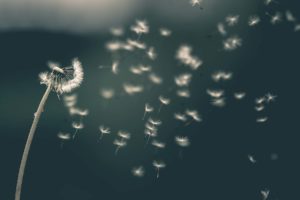San Bruno Mountain is a geologic anomaly, sitting alone like an unwanted stepchild, an island of open space in a sea of civilization. It was once thought to be an outlier of the Santa Cruz Mountains, but its skeleton is made from different material: the Santa Cruz Mountains are formed of granite, while San Bruno Mountain is its own terrane, formed of graywacke sandstone. Located in northern San Mateo County and surrounded by Daly City, Brisbane, South San Francisco, and Colma, it is viewed as a rather bland and bald chunk of dirt when seen from a fast-moving vehicle on Highway 101 or 280, an easy but mistaken assumption.
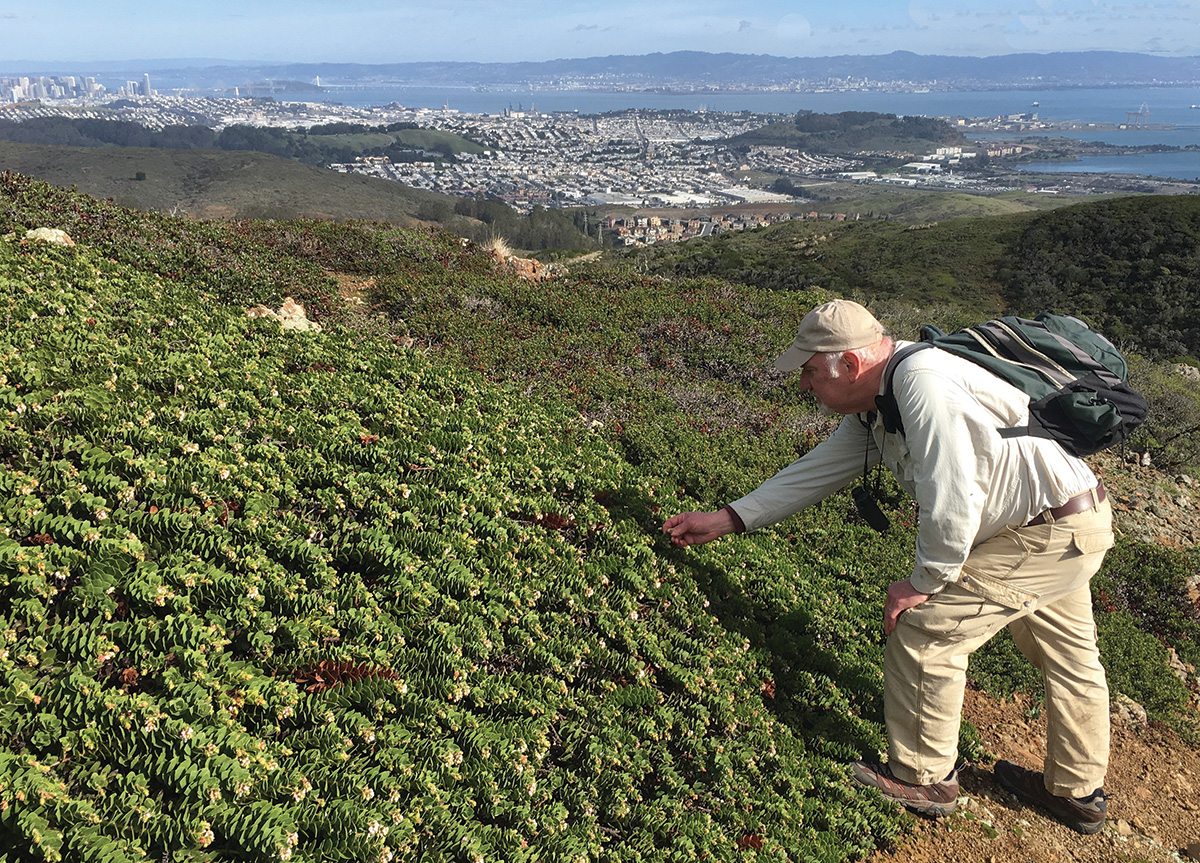
It is actually an ark for rare, endangered, and vulnerable plant and invertebrate species—13 plants and four federally listed butterflies. That it is still here is a miracle, considering that its top half was almost dumped as fill into the Bay in the 1960s to create a new development similar to Foster City but 14 times the volume in cubic feet. The Mountain (a term of endearment) is the last remaining vestige of what the tip of the San Francisco Peninsula looked like biologically when Europeans first arrived. It is part of the Franciscan Landscape, a unique geology that hosts an equally unique botanical diversity.
The Ericaceae (heather) family embodies the mysteries and enchantment of the California Floristic Province, which covers most of California, a small part of southwestern Oregon, and a bit of northwestern Mexico (Baja California). Of the Ericaceae, the manzanitas (genus Arctostaphylos) are the quintessential California native plants. Of the 107 species and subspecies worldwide, 97 are found in California. Over half of the California species are centered in the narrow coastal region between Mendocino and San Luis Obispo counties.
San Bruno Mountain has the distinction of hosting four endemic manzanitas: the eponymous San Bruno Mountain manzanita (Arctostaphylos imbricata), the Pacific manzanita (A. pacifica), and two forms of the common bearberry manzanita, Leo Brewer’s manzanita (A. uva-ursi forma leobreweri) and miniature manzanita (A. uva-ursi forma suborbiculata). For each of these four, there’s an interesting story about how it became known to and named by Western botanists. Two other species that grow on the mountain are brittle leaf manzanita, A. crustacea, and the rare Montara manzanita, A. montaraensis, whose only other known location is Montara Mountain to the south-west in Pacifica. Winter is “show time” for Bay Area manzanitas, as they bloom from late December to early March.
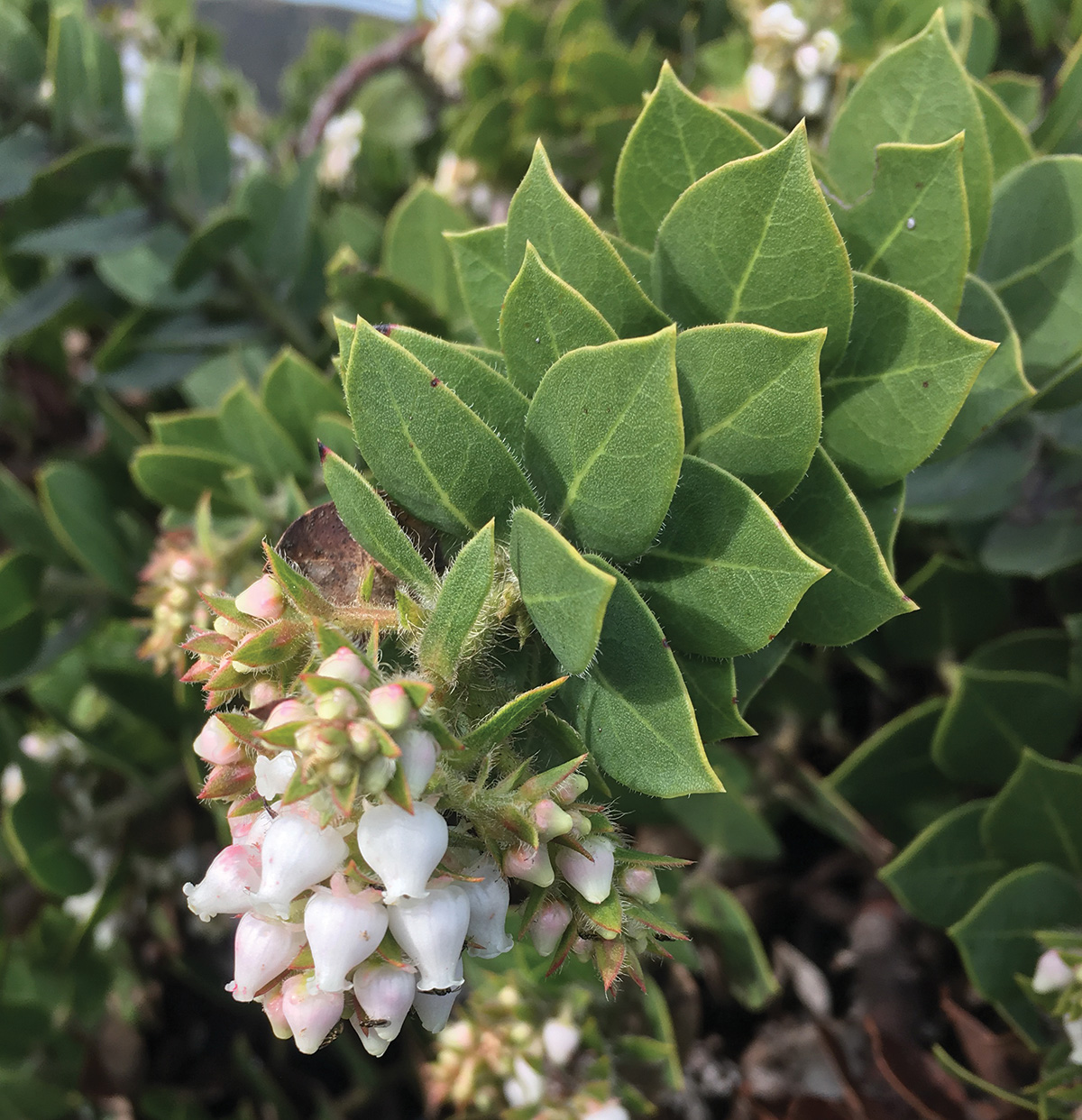
San Bruno Mountain manzanita (Arctostaphylos imbricata) was the first San Bruno Mountain endemic to be collected. Mrs. Ernest Meiere and Mrs. Marion Campbell found it in the “San Bruno hills” in 1915 and gave the specimen to Alice Eastwood, the famous botanist who rescued the California Academy of Science’s type specimens from the fires after the 1906 earthquake. She described it in 1931 in Proceedings of the California Academy of Sciences and named it San Bruno Mountain manzanita.
It is an attractive low-growing shrub that we have found in 11 locations on the mountain. This manzanita is not a federally listed endangered species (although it is listed as endangered by the state) because all the populations are “protected” by the San Bruno Mountain Habitat Conservation Plan (HCP). (We say “protected” in quote marks because its status did not prevent PG&E work crews from mowing one location to the ground in 2015!) It forms dense impenetrable tangles or mounds averaging about 28 centimeters in height. The fruit is hairy, and the bark is smooth, shiny, and mahogany in color. Like many chaparral species, this plant requires wildfire for reproduction. Fire suppression in its native habitat is one threat to its survival. It is ranked in the California Native Plant Society’s Inventory of Rare and Endangered Plants as 1B.1, the second rarest category of plants in the state.
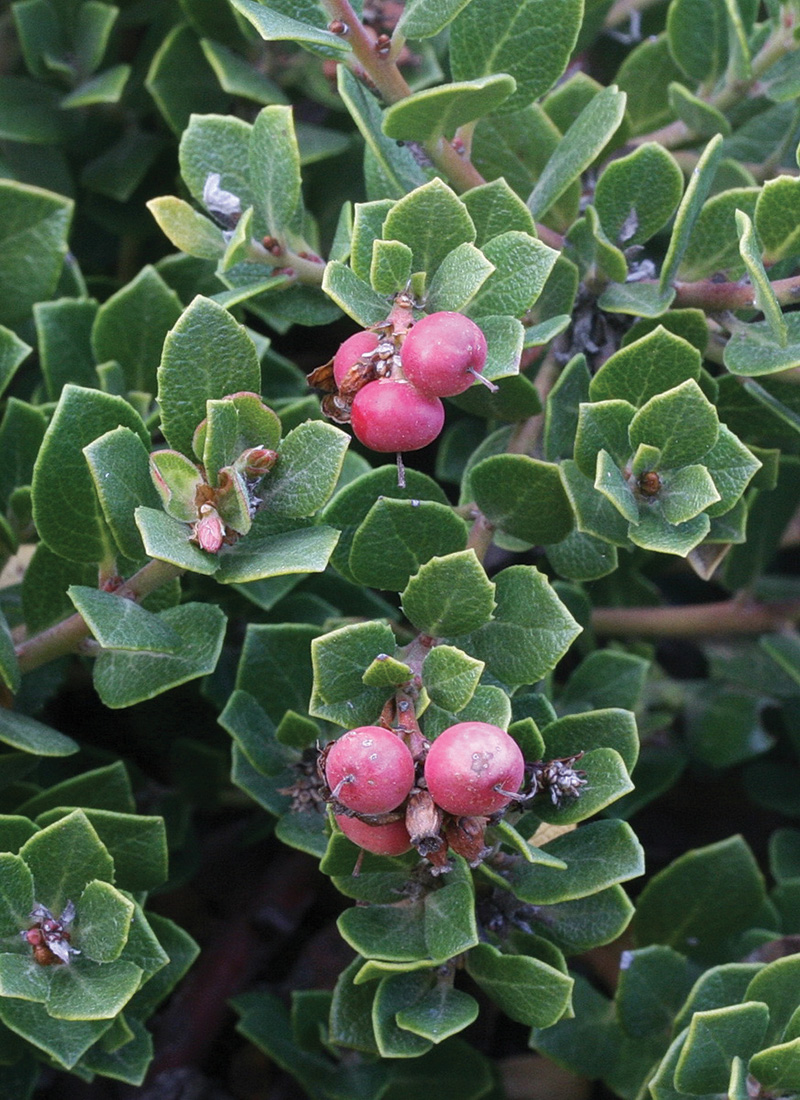
Pacific manzanita (Arctostaphylos pacifica) is the rarest manzanita on San Bruno Mountain: only two plants exist in the wild, and due to a petition by the authors of this article, it is also rated in the CNPS Inventory of Rare and Endangered Plants as 1B.1. It was first collected on April 18, 1961, by Jim Roof, a self-educated botanist who spent a great deal of time on San Bruno Mountain. He was the founding director of the Regional Parks Botanic Garden in Tilden Regional Park, was its director for 36 years, and has been characterized as a “cantankerous curmudgeon” by some. He described this species in 1962 in Leaflets of Western Botany, edited by Alice Eastwood. Roof noted that “it seems to represent a relict link between three maritime species of manzanita that occur on California’s Pacific littoral…” and thus gave it the specific epithet pacifica.
Pacific manzanita is a ground-hugging shrub, 10 to 20 centimeters tall, and spreads by self-rooting branches from ligno-tubers (woody rootstocks often giving rise to numerous aerial stems) located on the ground-hugging branches. The plants were almost destroyed by the Devil’s Arroyo fire in 1964 but survived by sprouting from their burls. Devil’s Arroyo is a wide canyon on the mountain’s east side, extending from the transmission towers at the summit to the lower park boundary. The fire likely burned several hundred acres, and we have not found a record of its cause or origin

Leo Brewer’s manzanita (Arctostaphylos uva-ursi forma leobreweri) was also discovered by Jim Roof, who named it for his friend Leo Brewer, a physical chemist at UC Berkeley. Known as the father of modern high-temperature chemistry, Brewer worked on the Manhattan Project. He was also a lover of native plants, and it has been said that he had one of the best native plant gardens in the Bay Area. He was a member of Citizens of Tilden Park and defended Roof when he was fired as director of the RPBG. Jim Roof had found the new manzanita on a hike in May of 1964; just five months later, it too was destroyed in the Devil’s Arroyo fire; burned to the ground, it never resprouted. Despite diligent searches, the plant never was found again.
However, Jim Roof had taken cuttings back to the RPBG, and Steve Edwards, Roof’s successor at the garden, gave some of the plants back to San Bruno Mountain park staff. Specimens were planted in three locations in 1987 by Roman Gankin, an environmental planner for San Mateo County Parks and a manzanita specialist, and Paul Reeberg, co-author with Elizabeth McClintock of A Flora of the San Bruno Mountains. The locations were kept secret. Reeberg showed one location to David Schooley, a tireless crusader for the preservation of the mountain, who in turn showed it to us. Three plants survive there. A botanist who saw that location with us tried to return to the site, took a wrong turn, and found a second site with two plants. Nearby was a rock on some chicken wire, and below was a nursery marker, with the words “Leobreweri OURS”. The planters had wanted us to find it! We have scoured the ridges for the third site, to no avail. Leo Brewer’s manzanita is a prostrate to mounding shrub up to 50 centimeters tall, with rooting branches and ligno-tubers at the base of some branches.
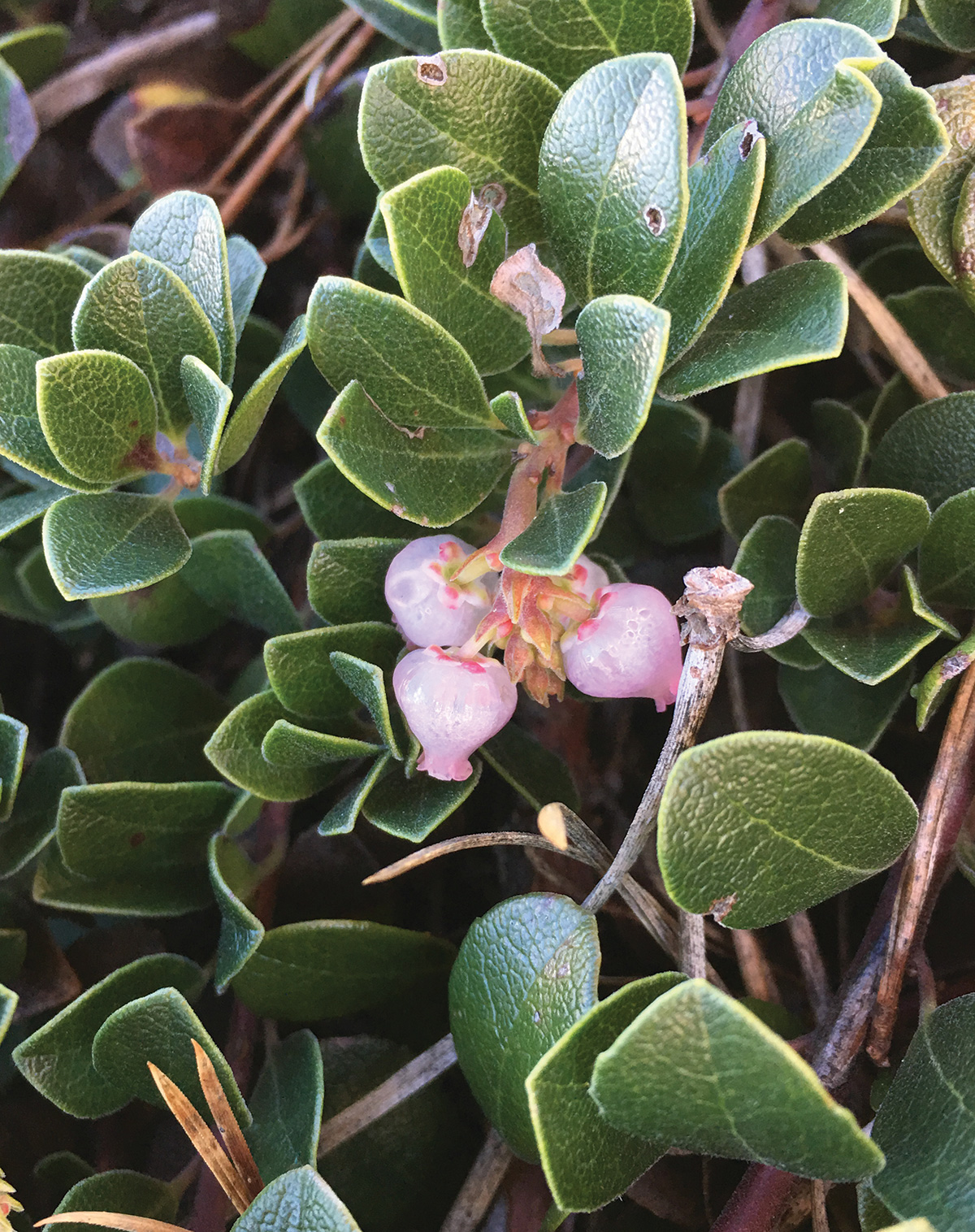
Miniature manzanita (Arctostaphylos uva-ursi forma suborbiculata) was described by Walter Knight, formerly the garden supervisor at the Regional Parks Botanical Garden, in The Four Seasons, the park’s botanical journal, in 1984. He found the plants 10 meters below Kamchatka Point, a rocky promontory at the intersection of the Summit and Ridge trails. Looking for another Ericaceae species, salal (Gaultheria shallon), in lower Cable Ravine on December 3, 2016, we discovered a second and much larger population of miniature manzanita in upper Cable Ravine, below Kamchatka Point.
Remember, they are an exotic species in the Western United States, and are rapidly increasing their geographic range and range of habitats. Are they outcompeting or excluding native species in the process? How would we know? We have done almost nothing to monitor changes in the assemblage of mushroom species in areas before and and after the incursion of death caps.
Further Reading
Pringle et al, “The ectomycorrhizal fungus Amanita phalloides was introduced and is expanding its range on the west coast of North America,” Molecular Biology 2009
Lockhart et al, “Simultaneous emergence of multidrug-resistant Candida auris on 3 continents confirmed by whole-genome sequencing and epidemiological analyses,” Clinical Infectious Diseases 2017
Battalani et al, “Aflatoxin B1 contamination in maize in Europe increases due to climate change,” Scientific Reports 2016
Explore the Mountain
»San Bruno Mountain State and County Park spans 2,416 acres of the mountain, with the summit reaching 1,314 feet. While both a county and state park, it is managed by the County of San Mateo Parks Department.
»A variety of trails cover 12 miles that include 360-degree views of the Pacific, San Francisco Bay, and the city. Dogs are not allowed. There is some trail access for bikes and equestrians.
»The main entrance, where there’s parking ($6 fee) along with restrooms and picnic tables, is at 555 Guadalupe Canyon Parkway in Brisbane. Learn more at parks.smcgov.org/san-bruno-mountain-state-county-park.
This spreading shrub is distinctly different from the other two forms of uva-ursi on the summit’s ridges. It shares space on Kamchatka Point with San Bruno Mountain manzanita and evergreen huckleberry (Vaccinium ovatum). Both manzanita species suffered an invasion of the native western tussock moth (Orgyia vetusta) but have recovered.
Anyone who spends some time wandering the rugged ridges and ravines of San Bruno Mountain certainly will discover a couple of intriguing truths about this unique botanical ark. First, we think the ratio of endemic, rare, and endangered species of all wildlife types to the landmass is unequaled in California. Second, many plants from any number of families just look different here than they do anywhere else. Those factors alone make botanizing such a fascinating and challenging activity in this venue. At the end of the day you will realize that it is also one of the most rewarding and exhilarating outdoor experiences you can have in an urban setting. And it is right here, in your backyard, hiding in plain view.
See you on the Mountain.





